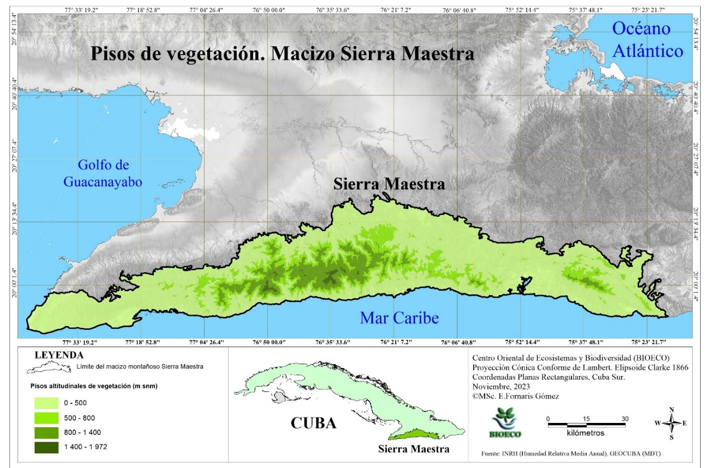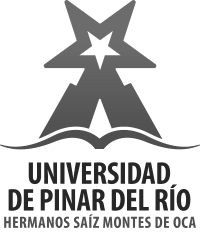The vegetation levels of the Sierra Maestra and the priority species for reforestation The vegetation levels of the Sierra Maestra and the priority species for reforestation
Main Article Content
Abstract
The Sierra Maestra is characterized by the large number of forest formations present in it, a consequence of the diversity of ecological conditions. Although these formations are largely altered, there is still a good representation of the composition of the original forests. This study aims to contribute to the conservation of this important natural heritage through restoration, rehabilitation and/or enrichment actions, with the species considered as priorities. These priorities were determined based on 180 phytocenological inventories that inventoried a total of 100 species present in the four vegetation levels found, following the altitudinal zoning proposed by several authors. These levels are: 1. Level of semi-deciduous forests and scrublands (Wetland zone, semi-deciduous microphyllous forests and scrublands and Semi-deciduous mesophyllous forest zone); 2. Evergreen Forest level; 3. Montane rainforest level and 4. Cloud Forest level. The selection of species is based on their high presence and dominance abundance. A characterization of the ecological factors present in the different ecotopes is presented, together with a map showing the distribution of vegetation belts. The criteria raised can be reflected in the strategies to be followed for forest management for conservation purposes in the Sierra Maestra.
Downloads
Article Details

This work is licensed under a Creative Commons Attribution-NonCommercial 4.0 International License.
References
ÁLVAREZ BRITO, A., MERCADET PORTILLO, A., OSIRIS ORTIZ, E.C., ORLIDIA HECHAVARRÍA, T.S., LILIANA CABALLERO, Y.R. y ANTONIO ESCARRÉ, R.L., 2014. El sector forestal cubano y el cambio climático. Anales de la Academia de Ciencias de Cuba [en línea], ISSN 2304-0106. Disponible en: https://revistaccuba.sld.cu/index.php/revacc/article/view/135.
BORHIDI, A., 1996. Phytogeography and Vegetation Ecology of Cuba [en línea]. S.l.: Akadémiai Kiadó. ISBN 9 63 05 6956 6. Disponible en: https://books.google.com.cu/books?id=MZclAQAAMAAJ&source=gbs_book_other_versions_r&cad=3.
CAPOTE, R.P. y BERAZAÍN, R., 1984. Clasificación De Las Formaciones Vegetales De Cuba. Revista del Jardín Botánico Nacional [en línea], vol. 5, no. 2, [consulta: 11 febrero 2025]. ISSN 0253-5696. Disponible en: https://www.jstor.org/stable/42596743.
GREUTER, W. y RANKIN RODRÍGUEZ, R., 2017. Plantas Vasculares de Cuba Inventario preliminar [en línea]. S.l.: Botanischer Garten & Botanisches Museum Berlin Jardín Botánico Nacional, Universidad de La Habana. Disponible en: https://www.researchgate.net/profile/Werner-Greuter/publication /321886706_Vascular_plants_of_Cuba_A_preliminary_checklist_Second_updated_Edition_of_The_Spermatophyta_of_Cuba_with_Pteridophyta_added /links/5a381f76458515919e71ed8a/Vascular-plants-of-Cuba-A-preliminary-checklist-Second-updated-Edition -of-The-Spermatophyta-of-Cuba-with-Pteridophyta-added.pdf.
GUEVARA, V., GUTIÉRREZ, T. y BOUDET, T., 2019c. Evapotranspiración de referencia media anual. En Atlas Nacional de Cuba, Epígrafe 2.4: Clima. [en línea]. La Habana, Cuba: Instituto de Geografía Tropical. Mapas multimedias. Disponible en: https://atlas.geotech.cu/wp-content/uploads/2021/01/Ep%C3%ADgrafe -2.4-Clima-2.pdf.
GUEVARA, V., GUTIÉRREZ, T. y BOUDET, T., 2019b. Humedad relativa media anual del aire y diagrama de isopletas trihorarias. En Atlas Nacional de Cuba, Epígrafe 2.4: Clima. [en línea]. La Habana; Cuba: Instituto de Geografía Tropical. Mapas multimedias. Disponible en: https://atlas.geotech.cu/wp-content/uploads/2021/01/Ep%C3%ADgrafe-2.4-Clima-2.pdf.
GUEVARA, V., GUTIÉRREZ, T. y BOUDET, T., 2019a. Radiación media anual. En Atlas Nacional de Cuba, Epígrafe 2.4: Clima [en línea]. La Habana; Cuba: Instituto de Geografía Tropical. Mapas multimedias. Disponible en: https://atlas.geotech.cu/wp-content/uploads/2021/01/Ep%C3%ADgrafe-2.4-Clima-2.pdf.
INSTITUTO DE GEOLOGÍA Y PALEONTOLOGÍA (IGP), 2014. Léxico estratigráfico de Cuba (C. N. d. I. Geológica. Tercera. La Habana, CUBA: Instituto de Geología y Paleontología Servicio Geológico de Cuba/Ministerio de Energía y Minas.
PÉREZ, C.B., 2017. Comportamiento fisiográfico, geográfico y estacional de la insolación en Cuba, 1981 2013. Revista Cubana de Higiene y Epidemiología [en línea], vol. 55, no. 2, [consulta: 11 febrero 2025]. ISSN 1561-3003. Disponible en: https://revepidemiologia.sld.cu/index.php/hie/article/view/62.
RENDA, A., CALZADILLA, E., BOUZA, J.A., ARIAS, J. y VALLE, M., 1981. Estudio edafológico, fisiográfico y agrisilvicultural de la Sierra Maestra, Municipio Guisa. Provincia Granma. S.l.: Ministerio de la Agricultura, Centro de Investigación Forestal.
REYES, O.J., 2011. Clasificación de la vegetación de la Región Oriental de Cuba. Revista del Jardín Botánico Nacional [en línea], vol. 32, no. 33, [consulta: 3 octubre 2024]. Disponible en: https://www.jstor.org/stable/23725915.
REYES, O.J. y ACOSTA, F., 2005. Vegetación. Cuba: Parque Nacional La Bayamesa. En: D. MACEIRA, T. WACHTER y F. ALVERSON (eds.), Rapid Biological Inventories. Chicago: The Field Museum, pp. 43-50.
REYES, O.J. y ACOSTA, F., 2019. Bosque nublado, sus fitocenosis y vulnerabilidades ante el cambio climático. Revista Forestal Baracoa, vol. 38, no. 1,
REYES, O.J., FERRER, E.P., NOVOA, E.V. y GÓMEZ, E.F., 2010. Características fisonómicas y funcionales de los bosques de Cuba Oriental. I. El bosque nublado de la Sierra Maestra. Foresta Veracruzana [en línea], vol. 12, no. 1, [consulta: 11 febrero 2025]. ISSN 1405-7247,. Disponible en: https://www.redalyc.org/articulo.oa?id=49720264001.
REYES, O.J., PELICIÉ, O., VINENT, C., LABRADA, L.M., SEMANAT, E. y FORNARIS, E., 2005. Estudio fisionómico y funcional de las pluvisilvas montanas de la gran piedra, Cuba. Foresta Veracruzana [en línea], vol. 7, no. 2, [consulta: 11 febrero 2025]. ISSN 1405-7247,. Disponible en: https://www.redalyc.org/articulo.oa?id=49770202.
RICARDO-NÁPOLES, N.E., OLIVER, P.P., CEJAS-RODRIGUEZ, F. y ORTIZ, J., 2009. Tipos y características de las formaciones vegetales de Cuba. Acta Botánica Cubana [en línea], vol. 203, Disponible en: https://repositorio.geotech.cu/xmlui/bitstream/handle/1234/660 /Tipos%20y%20caracter%C3%ADsticas%20formaciones%20vegetales%20Cuba%202da%20parte.pdf?sequence=2&isAllowed=y.
RODRÍGUEZ, F., 2006. Nuevos logros en el estudio de la pluviosidad en Cuba: Mapa Isoyético para el período 1961-2000. Revista Voluntad hidraúlica [en línea], vol. 98, no. 1, Disponible en: http://dx.doi.org/10.29104/phi-aqualac/2020-v12-1-08.
SAMEK., V., 1975. Hohenstufengliederung der Sierra Maestra (Kuba) und die Vegetation der Supramontanen Stufe. S.l.: Arch. Bereich Waldbau-Forstschutz, TU Dresden ºpaperº.
SAMEK, V. y TRAVIESO, A., 1968. y (1968). Climaregiones de Cuba. Rev. Agricultura 2: 5-23. Rev. Agricultura, vol. 2,


